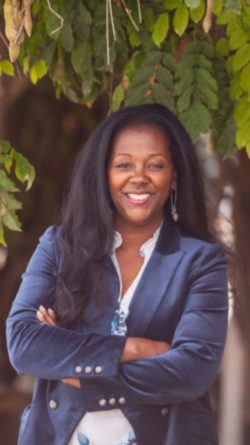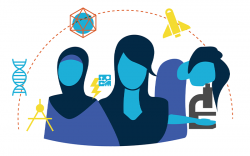Meet Kimberly Harper – Physical Scientist, U. S. Department of Energy and Notable Woman in STEM
Recently, we had the opportunity to (virtually) interview Kimberly Harper, Physical Scientist with the U. S. Department of Energy’s Office of Science, to learn more about her career path and work. Read on to learn more about her career path.
Would you please introduce yourself and explain to us what you do?

My name is Kimberly Harper. I work as a Physical Scientist within The U. S. Department of Energy’s Office of Science, where I’m on a team of 35 scientists, engineers, and subject matter experts. We are responsible for overseeing Battelle’s management and operation of the Pacific Northwest National Laboratory (PNNL). I read all kinds of scientific and technological proposals and evaluate whether PNNL has the appropriate facilities, equipment, staff, and safety protocols in place to conduct the proposed research. And because PNNL is a government owned Laboratory, I pay close attention to how American tax dollars—which fund much of what PNNL does—are being spent.
What was your education and/or career path?
I have a Bachelor of Science degree in Chemistry from the University of Arkansas at Pine Bluff. I also minored in Mathematics.
How did you get where you are now?
I interviewed for my job – before I graduated from college – during an on-campus job fair. It took a while for me to hear back, and during the wait, I landed a job doing something that I absolutely LOVE (even still today) – TEACHING! I taught middle and high school math, algebra, and geometry. What an honor it was/is to teach! Being able to influence and shape young minds and to help students reach their full potential is probably one of the most rewarding forms of ‘work’ on the planet!
Towards the end of the school year, I heard back from DOE about the job that I’d applied for, over 6 months earlier. It wasn’t an easy decision to make, but I decided to leave my home state of Arkansas – and a job that I loved – to move out West. What’s been really rewarding about my job is that I’ve had an opportunity to continue inspiring, mentoring, and teaching young people throughout my career. I’ve spent the past 26 years promoting the importance of Science, Technology, Engineering, and Math to young people, but especially girls! I’ve volunteered as a judge for local science bowls; managed the DOE Regional Science Bowl; officiated at the National Science Bowl; helped mentor students in pursuing STEM based degrees and careers; and even founded my own mentorship program (e-MERGE) for girls – focused on the importance of merging STEM literacy with leadership development and community service.
What/who were some of your most important influences that guided you to STEM?

You probably won’t be surprised by the answer. My very first and most important influences – guiding me towards STEM – were my parents and my teachers. They all stressed the importance of a good education and the wonder of absorbing information and knowledge. Once I figured out how much fun it was to learn new things, I gravitated towards math and science. I think that kids are natural explorers. STEM is all about exploration. I work with some of the world’s smartest people, and the one thing that they all have in common is their belief that there is ALWAYS more to learn! In STEM, there is always a question in search of a mind that is curious enough to seek out its answer. And they also recognize that answers can sometimes change/evolve as more information/data is discovered. Sometimes science, and especially math, get a bad rep! I think that’s because both subjects thrive off the journey towards the answer. And let’s be honest… Who wants to take a journey, only to feel like they’ve arrived at the wrong destination? The important thing to remember is that, in STEM – the journey is the POINT! That’s because the information, picked up along the way, is sometimes just as important as the destination. Maybe that data leads to a better destination?
Do you know what I’ve learned from being around so many smart people? I’ve learned that they’re as smart as they are because they’ve discovered that the key to gaining more knowledge is, first, realizing that they don’t have all the answers. And what’s interesting is – when they DO find an answer, it usually leads them to more questions. And most important, they don’t typically find these answers on their own. They generally team up with other curious people to conduct their explorations. Why? Because the best ideas always come from a diversity of thought! So, besides my parents and teachers, I’d say that I’ve been heavily influenced by all the smart people around me.
What is your favorite part of your job?
My favorite part of my job is being able to work with so many different types of people who bring a variety of perspectives to our work.
What do you consider your biggest achievement in STEM?
My biggest achievement is seeing the impact that my mentorship has had on shaping our e-MERGE participants’ thoughts about who they are and who they can become.
Are there any stereotypes about women in STEM you’d like to personally dispel?
I can say that I have seen a marked improvement over the past 26 years. Sure… There is still a ton of work to do, but women are demonstrating every day that they are capable of leading and enabling some of the world’s most dynamic and impactful discoveries. I see it in real-time, every day. Women are leading some of the nation’s most prevalent areas of research. As women continue to excel in our discoveries – answering the world’s most elusive questions – any attempts to silence our voices, dim our light, or minimize our impact can only become more and more unsuccessful. Women’s influence, and our unique way of problem solving, becomes more accepted as we shed antiquated ideas about what we can and should be lending our talents to. There isn’t anything that we can’t achieve. It is imperative that we continue to teach our girls the same messages – early and often.
What unique qualities do you think girls and women bring to STEM?
From my experience, women’s approach to problem solving is deeply thoughtful and impactful. By nature, we are nurturers and collaborators, so when we think about how to fix something or how to answer a question, oftentimes we may think about how the outcome will affect the world around us. That’s not to say that ambition never comes into play with women. I do think that even when recognition and/or wealth is on the table, it isn’t uncommon for a woman to account for how her work may impact others and how she can elevate her teammates. Because of that little innate quality, solutions developed by women oftentimes have longevity, significant impact to a wider variety of people, and they may even offer a make-you-feel-good quality! In the examples that I’ve experienced, that innate quality comes from having to accomplish impressive career goals while juggling families, work, home responsibilities, and community commitments simultaneously. It also comes from having to prove herself to doubters over and over again – while still having to juggle multiple responsibilities. I also think that women – even when we may not feel like it – are very used to collaborating, maintaining cool dispositions, and figuring out how to effectively (yet politely) express our challenges. Women have an intense resilience to never quit. We have a unique capacity for multi-tasking. We have the ability to strive, while remaining reflective and mindful of what it took/takes to achieve our goals. That truly sets us apart.
How do you see science, technology, engineering, and/or math working together in your current job?
Today’s industries, fields of study, and scientific discoveries depend heavily on interdisciplinary applications of STEM. I work at a multi-program, multi-disciplinary National Laboratory – responsible for close to a billion-dollar budget – where they use their resources, expertise, and capabilities to solve the nation’s most challenging scientific, energy, environmental, and national security problems. It is imperative that science, technology, engineering, and math all work together in the discovery of those solutions.
What would you like to say to young women thinking about beginning a career in STEM?
Do it! And please don’t pressure yourself to quickly choose one field over the other. Take classes. Talk to people in different careers. Explore your interests through different internships and opportunities to learn. Today, there are many interdisciplinary fields of study. As an example, maybe you like working with computers and studying biology. Bioinformatics is an extremely important field. Being able to model real-world biological problems on a computer helps the scientists to hone-in on the details of their experiment before they go out into the field or into the laboratory. Similarly, field/laboratory experiments can be honed via a computer model – preserving the limited use of hard-to-come-by samples.
What do you think is unique about Washington and the STEM careers in our state?
One of the things that I think is so unique about Washington, and STEM careers in the state, is the obvious nexus between agriculture/agronomy/viticulture and STEM (specifically Eastern Washington’s grape/wine industry). Regional colleges have created wine science programs to ensure that we take advantage of that nexus. There are also countless opportunities to advance STEM at the regional, national, and global scale because we have a National Laboratory, world class universities, and a thriving high-tech industry in our state.
Can you share a fun fact about yourself?
I was once a car saleswoman. It was a job that I had while attending college. I really didn’t like sales, but it was a nice way to earn extra money. I was actually pretty good at it too – which is funny to me.